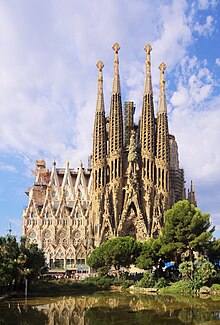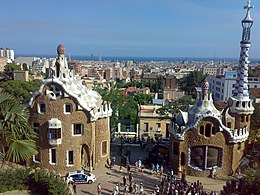Sagrada Família
| Basílica de la Sagrada Família | |
|---|---|
Basílica de la Sagrada Família
| |

Nativity Façade in August 2017
| |
| Religion | |
| Affiliation | Roman Catholic |
| District | Barcelona |
| Ecclesiastical or organizational status | Minor basilica |
| Leadership | Juan José Cardinal Omella, Archbishop of Barcelona |
| Year consecrated | 7 November 2010 by Benedict XVI |
| Status | Active/under construction |
| Location | |
| Location | Barcelona, Spain |
| Geographic coordinates | 41°24′13″N 2°10′28″ECoordinates: 41°24′13″N 2°10′28″E |
| Architecture | |
| Architect(s) | Antoni Gaudí |
| Style | Modernisme |
| General contractor | Construction Board of La Sagrada Família Foundation[1] [dubious ] |
| Groundbreaking | 19 March 1882 |
| Specifications | |
| Direction of façade | Southeast |
| Capacity | 9,000 |
| Length | 90 m (300 ft)[2] |
| Width | 60 m (200 ft)[2] |
| Width (nave) | 45 m (150 ft)[2] |
| Spire(s) | 18 (8 already built) |
| Spire height | 170 m (560 ft) (planned) |
| Website | |
| sagradafamilia | |
| Part of | Works of Antoni Gaudí |
| Criteria | Cultural: i, ii, iv |
| Reference | 320-005 |
| Inscription | 2005 (29th session) |
The Basílica de la Sagrada Família (Catalan: [bəˈzilikə ðə lə səˈɣɾaðə fəˈmiljə]; Spanish: Basílica de la Sagrada Familia; ('Basilica of the Holy Family')),[3] also known as the Sagrada Família, is a large unfinished Roman Catholic minor basilica in Barcelona, Catalonia, Spain. Designed by Spanish/Catalan architect Antoni Gaudí (1852–1926), his work on the building is part of a UNESCO World Heritage Site.[4] On 7 November 2010, Pope Benedict XVI consecrated the church and proclaimed it a minor basilica.[5][6][7]
On 19 March 1882, construction of the Sagrada Família began under architect Francisco de Paula del Villar. In 1883, when Villar resigned,[4] Gaudí took over as chief architect, transforming the project with his architectural and engineering style, combining Gothic and curvilinear Art Nouveau forms. Gaudí devoted the remainder of his life to the project, and he is buried in the crypt. At the time of his death in 1926, less than a quarter of the project was complete.[8]
Relying solely on private donations, the Sagrada Família's construction progressed slowly and was interrupted by the Spanish Civil War. In July 1936, revolutionaries set fire to the crypt and broke their way into the workshop, partially destroying Gaudí's original plans, drawings and plaster models, which led to 16 years work to piece together the fragments of the master model.[9] Construction resumed to intermittent progress in the 1950s. Advancements in technologies such as computer aided design and computerised numerical control (CNC) have since enabled faster progress and construction passed the midpoint in 2010. However, some of the project's greatest challenges remain, including the construction of ten more spires, each symbolising an important Biblical figure in the New Testament.[8] It is anticipated that the building can be completed by 2026, the centenary of Gaudí's death.[10]
The basilica has a long history of splitting opinion among the residents of Barcelona: over the initial possibility it might compete with Barcelona's cathedral, over Gaudí's design itself, over the possibility that work after Gaudí's death disregarded his design,[11] and the 2007 proposal to build a tunnel of Spain's high-speed rail link to France which could disturb its stability.[12] Describing the Sagrada Família, art critic Rainer Zerbst said "it is probably impossible to find a church building anything like it in the entire history of art",[13] and Paul Goldberger describes it as "the most extraordinary personal interpretation of Gothic architecture since the Middle Ages".[14] The basilica is not the cathedral church of the Archdiocese of Barcelona, as that title belongs to the Cathedral of the Holy Cross and Saint Eulalia.
Casa Milà
(Redirected from La Pedrera)
| Casa Milà | |
|---|---|
La Pedrera
| |

Casa Milà
| |
| General information | |
| Address | 92, Passeig de Gràcia |
| Town or city | Barcelona, Catalonia |
| Country | Spain |
Casa Milà (Catalan pronunciation: [ˈkazə miˈla], Spanish pronunciation: [ˈkasa miˈla]), popularly known as La Pedrera (pronounced [ɫə pəˈðɾeɾə]) or "The stone quarry", a reference to its unconventional rough-hewn appearance, is a modernist building in Barcelona, Catalonia, Spain. It was the last private residence designed by architect Antoni Gaudí and was built between 1906 and 1912.
The building was commissioned in 1906 by Pere Milà and his wife Roser Segimon. At the time, it was controversial because of its undulating stone facade, twisting wrought iron balconies and designed by Josep Maria Jujol. Several structural innovations include a self-supporting stone façade, and a free-plan floor, underground garage and the spectacular terrace on the roof.
In 1984, it was declared a World Heritage Site by UNESCO. Since 2013 it has been the headquarters of the Fundació Catalunya La Pedrera which manages the visit to the building,[1] exhibitions and other cultural and educative activities at Casa Milà.
Park Güell
| Park Güell | |
|---|---|

The two buildings at the entrance of the park
| |
| Location | Gràcia, Barcelona, Catalonia, Spain |
| Coordinates | 41°24′49″N 2°09′10″ECoordinates: 41°24′49″N 2°09′10″E |
| Established | 1914 |
| Part of | Works of Antoni Gaudí |
| Criteria | Cultural: i, ii, iv |
| Reference | 320-001 |
| Inscription | 1984 (8th session) |
| Extensions | 2005 |
The Park Güell (Catalan: Parc Güell [ˈpaɾɡ ˈɡweʎ]; Spanish: Parque Güell) is a public park system composed of gardens and architectonic elements located on Carmel Hill, in Barcelona, Catalonia, Spain. Carmel Hill belongs to the mountain range of Collserola – the Parc del Carmel is located on the northern face. Park Güell is located in La Salut, a neighborhood in the Gràcia district of Barcelona. With urbanization in mind, Eusebi Güell assigned the design of the park to Antoni Gaudí, a renowned architect and the face of Catalan modernism.
The park was built from 1900 to 1914 and was officially opened as a public park in 1926. In 1984, UNESCO declared the park a World Heritage Site under "Works of Antoni Gaudí".[1]
Camp Nou
 | |
| Full name | Camp Nou |
|---|---|
| Former names | Estadio del Club de Fútbol Barcelona (1957-1973) Estadi del Futbol Club Barcelona (1973-2001)[1] |
| Location | Barcelona, Spain |
| Coordinates | 41.38087°N 2.122802°E |
| Public transit | |
| Owner | FC Barcelona |
| Executive suites | 23[2] |
| Capacity | 99,354 [3] |
| Record attendance | 98,812 (FC Barcelona vs Arsenal F.C.), 2019 Joan Gamper Trophy Final |
| Field size | 105 m × 68 m (115 yd × 74 yd)[4] |
| Surface | GrassMaster hybrid grass |
| Scoreboard | Sony |
| Construction | |
| Built | 1954–1957 |
| Opened | 24 September 1957[4] |
| Renovated | 1995, 2008, 2018 |
| Construction cost | €1.73 billion |
| Architect | Francesc Mitjans and Josep Soteras |
| Tenants | |
| FC Barcelona (1957–present), Catalonia National Team | |
Camp Nou (Catalan pronunciation: [ˌkamˈnɔw], meaning new field, often referred to in English as the Nou Camp)[5][6] has been the home stadium of FC Barcelona since its completion in 1957, and it is located in Carrer d'Arístides Maillol.[7]
With a seating capacity of 99,354,[8] it is the largest stadium in Spain and Europe, and the third largest football stadium in the world in capacity. It has hosted two European Cup/Champions League finals in 1989 and 1999, two UEFA Cup Winners' Cup finals, four Inter-Cities Fairs Cup final games, five UEFA Super Cup final games, four Copa del Rey finals, two Copa de la Liga final games, twenty-one Supercopa de España final games, five matches including the opening game of the 1982 FIFA World Cup, two out of four matches at the 1964 European Nations' Cup and the football competition final at the 1992 Summer Olympics.
Aquarium Barcelona
(Redirected from L'Aquarium Barcelona)

Shark tunnel at the aquarium
| |
| Date opened | 8 September 1995[1] |
|---|---|
| Location | Barcelona, Catalunya, Spain |
| Coordinates | 41°22′36″N 2°11′03″ECoordinates: 41°22′36″N 2°11′03″E |
| No. of animals | 11,000[1] |
| No. of species | 450[1] |
| Volume of largest tank | 3,700,000 l (980,000 US gal)[2] |
| Total volume of tanks | 5,000,000 l (1,300,000 US gal)[3] |
| Memberships | AIZA[4] |
| Owner | Aspro Parks |
| Website | www |
Aquarium Barcelona (Catalan: Aquàrium de Barcelona, IPA: [əˈkwaɾi.um də βəɾsəˈlonə]) is an aquarium located in Port Vell, a harbor in Barcelona, Catalonia, Spain.
The 35 aquariums at the facility are home to 11,000 animals representing 450 species.[1][3] The aquarium contains a total of 5,000,000 l (1,300,000 US gal).[3] This includes an ocean tank for sharks, rays and other large fish, which is 36 m (118 ft) in diameter, 5 m (16 ft) deep, contains 3,700,000 l (980,000 US gal) of water and has an 80-meter (260 ft) underwater tunnel.[2] The Aquarium of Barcelona is part of the Aspro Parks.[1]
